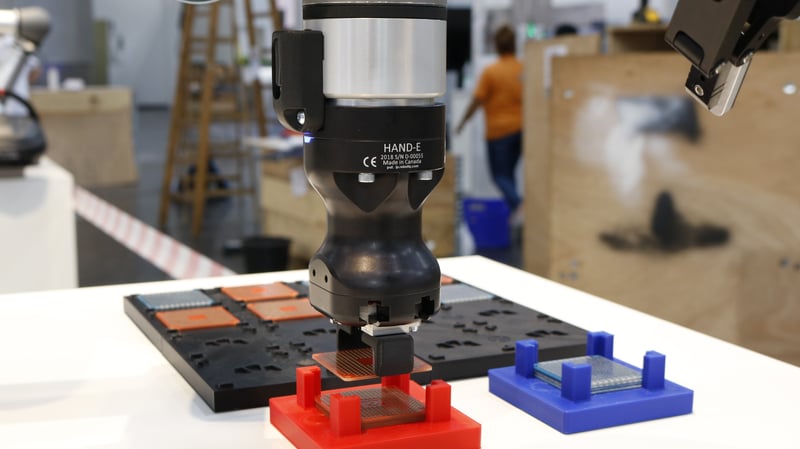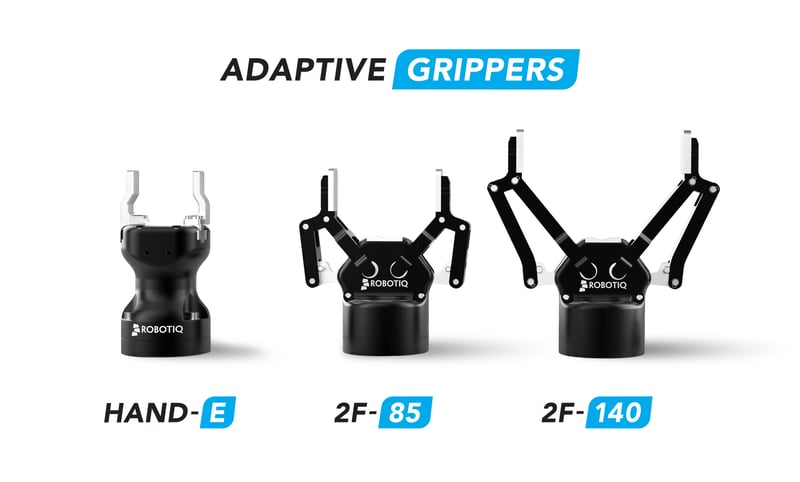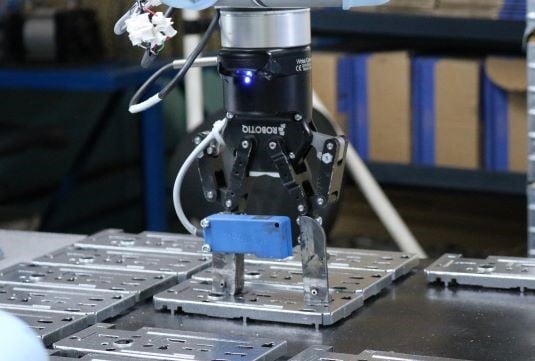20 Reasons Why You Should Invest in a Precision Gripper

Posted on Jul 11, 2018 in Robot Grippers
6 min read time
What's the benefit of a precision gripper over any other? Here are 20 reasons why a precision gripper is well worth it.
Choosing the right robotic gripper can be a tough decision. There are so many on the market, it's hard to figure out which is best for your purposes.
And with the recent release of our Hand-E Adaptive Gripper, the range of options just got even wider. You might be wondering: Do I really need a precision gripper?
Here are 20 qualities of precision grippers that make them a worthwhile investment:
1. Ability to handle small parts
Perhaps the most obvious benefit of a precision gripper is that it can accurately manipulate small parts. This is becoming more and more important for tasks like assembly, machine tending, and quality testing.
A few years ago, cobots were best suited to imprecise pick and place tasks, but now they're precise enough to tackle almost any task.
2. Sub-mm precision
The precision of a gripper has a huge effect on whether you can use a robot for detailed tasks. Our Hand-E gripper has a sub-mm precision, whereas our other Adaptive Grippers are better suited to tasks that require only millimeter-level precision.
3. Sub-mm part detection
Part detection refers to a gripper's ability to verify that an object is present just by grasping it. Our grippers all have this capability, but with varying degrees of precision. Hand-E can detect the size of a part down to the sub-mm level.
Validate your part with the Grip Check Node on the Adaptive Grippers URCap.
4. True translational motion
The fingers of our other 2-Finger Adaptive Grippers use a parallel linkage mechanism. This keeps the fingertips parallel, but it also means they follow a slightly curved motion as they close. Hand-E, on the other hand, has truly translational motion.
See our article Parallel Robot Grippers: Which is Best? for an explanation of the benefits of translational grippers.
5. Better control
One of the advantages of a translational gripper is the high degree of control it gives you. You can be sure the fingertips will follow a precise linear motion throughout the grasp, so they're all set to handle delicate parts like small electronic boards.
6. Easier to control
True translational motion also makes the gripper easier to control for precision applications.
For example, with the 2F-85 and 2F-140 Grippers, picking a thin part from a tabletop can be tricky. You have to offset the gripper a little to counteract the effect of the curved fingertip motion.
With Hand-E, you can touch the fingertips close to the surface and be sure that they'll remain at the same distance from the surface throughout the motion.
7. Precise force settings
Picking up delicate parts is only possible if you can precisely control the force applied by the gripper. With Hand-E, as with the other Adaptive Grippers, you can precisely control the gripping force. Hand-E has a force range of 60–130 N, and you can control the force in increments of 0.27 N.
8. Easy to hand-guide
Hand-guiding is an easy way to program a robot: you just move the robot to where you want it and save the position to the robot program. But whereas some grippers are hard to grab, Hand-E is designed to be easy to grab, which makes hand-guiding even easier.
9. Simple to program
Some grippers add a surprising amount of programming complexity. Others, like Hand-E, can be programmed within minutes.

All three Robotiq Adaptive Grippers have the same intuitive programming software.
10. Precise speed settings
When you need a gripper to pick up large, durable objects, the exact speed of motion is not so important. However, precise applications often require you to set the closing speed.
The speed of a precision gripper should be controllable down to fractions of a millimeter. You can set Hand-E's speed in real time by increments of 0.5 mm/s.
11. Manufactured to low tolerances
The only way to build a "precision" gripper is to manufacture it to low tolerances. This is certainly the case with Hand-E, which has been manufactured to the lowest tolerances of all our grippers.
12. Potentially cableless
Cables are a pain: they spoil your nice, sleek robot by running up the robot's arm. However, there's no need for cables when you use Hand-E with the UR e-Series robots, since the e-Series has internal cabling that plugs directly into the gripper.
The thermostat assembly demo used Hand-E with a normal UR robot and had cables running up the arm. The pick-and-place demo used an e-Series robot with no cables. Doesn't it look so much neater?
 No more cables! Hand-E is ready for the Universal Robots e-Series.
No more cables! Hand-E is ready for the Universal Robots e-Series.
13. Highly durable
Although a precision gripper is designed to handle small and delicate objects, it should not be delicate itself. The mechanical design and fabrication of the gripper should be durable enough to withstand tough industrial environments and demanding tasks.
14. Sealed from contaminants
Industrial environments are often filled with dust, dirt, and liquid. Since precision grippers are often used in these environments, they should be sealed to protect against such contaminants. Hand-E has been manufactured to withstand environments with lots of liquid and dust.
15. Highly reliable
All our Adaptive Grippers are reliable, but this is particularly true for Hand-E, which is targeted at demanding precision tasks. Plus, keep downtime to a minimum by combining it with Insights.
16. Quicker to deploy
Many of the above benefits, especially the simplicity of programming and ease of control, make Hand-E quick to deploy. In most cases, you can have it up and running within an hour.
17. Quicker to earn an ROI
A quicker deployment also means you'll see a return on investment (ROI) sooner. Also, since some precision tasks are value-added tasks (e.g., precise assembly) it can be easier to work out the ROI for these than it is for non-value-added tasks.
18. Small footprint
A precision gripper shouldn't take up a lot of space, because precision tasks often have to be carried out in a restricted workspace. This makes such tasks difficult for a lot of bulky cobot grippers. Hand-E, on the other hand, has a working envelope of just 75 mm, meaning it can fit into very small spaces.
19. Highly customizable
One property of precision tasks is that they often require custom fingertips. Small, shiny, or otherwise-awkward gripping points can be handled by making new fingertips or modifying existing ones.
With Hand-E, it's easy to create new fingertips and attach them to the actuation rack in minutes.
20. Highly versatile
Even if you're just using the supplied aluminum fingertips, Hand-E is a very versatile gripper. It can handle a huge range of objects with a high degree of precision.
This versatility is what makes Hand-E, as well as the rest of our Adaptive Gripper range, so useful for many applications. And that's why a precision gripper is well worth the investment.









Leave a comment